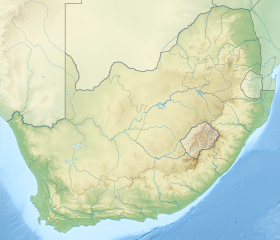Lac Sainte-Lucie
| Sainte-Lucie | ||
 False Bay, Lac Sainte-Lucie | ||
| Administration | ||
|---|---|---|
| Pays | Afrique du Sud | |
| Subdivision | KwaZulu-Natal | |
| Fait partie de | St. Lucia Game Park (en) et St. Lucia System (d) | |
| Géographie | ||
| Coordonnées | 28° 00′ S, 32° 30′ E | |
| Type | Lac naturel | |
| Superficie | 300 km2 |
|
| Longueur | 40 km | |
| Largeur | 21 km | |
| Profondeur · Maximale |
3 m |
|
| Hydrographie | ||
| Alimentation | Hluhluwe River (en) | |
| Géolocalisation sur la carte : Afrique du Sud
| ||
| modifier |
||
Le lac Sainte-Lucie est un système lacustre estuarien situé dans le nord du KwaZulu-Natal en Afrique du Sud. C’est le plus grand lac estuarien d’Afrique australe, couvrant une superficie d’environ 350 kilomètres carrés, il se trouve dans le Parc de la zone humide d'iSimangaliso (un site du patrimoine mondial).
Histoire
[modifier | modifier le code]Le lac a été nommé Santa Lucia par Manuel Perestrello le 13 décembre 1575, le jour de la fête de Sainte-Lucie[1]. Il a été rebaptisé plus tard Sainte-Lucie.
Flore et faune
[modifier | modifier le code]Plus de 2180 espèces de plantes à fleurs ont été répertoriées dans le système lacustre de Sainte-Lucie[2]. Le lac Sainte-Lucie abrite une faune riche, notamment des crocodiles, des hippopotames, des lézards, plus de 400 espèces d’oiseaux, des invertébrés et occasionnellement des requins[3],[4].
Notes et références
[modifier | modifier le code]- Santa Lucia: http://www.santalucia.co.za/history.php « https://web.archive.org/web/20150910051615/http://www.santalucia.co.za/history.php »(Archive.org • Wikiwix • Archive.is • Google • Que faire ?), , retrieved 8 August 2015
- Michele Thieme, Robin Abell, Neil Burgess, Bernhard Lehner, Eric Dinerstein et David Olsen, Freshwater Ecoregions of Africa and Madagascar: A Conservation Assessment, Island Press, , p. 331
- Nel, H.A., Perissinotto, R. & Taylor, R.H. 2012. Diversity of bivalve molluscs in the St Lucia Estuary, with an annotated and illustrated checklist. African Invertebrates 53 (2): 503-525.« Archived copy » [archive du ] (consulté le )
- Perissinotto, R., Taylor, R.H., Carrasco, N.K. & Fox, C. 2013. Observations on the bloom-forming jellyfish Crambionella stuhlmanni (Chun, 1896) in the St Lucia Estuary, South Africa. African Invertebrates 54 (1): 161–170.« Archived copy » [archive du ] (consulté le )
Text is available under the CC BY-SA 4.0 license; additional terms may apply.
Images, videos and audio are available under their respective licenses.

